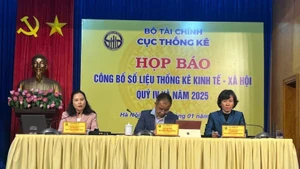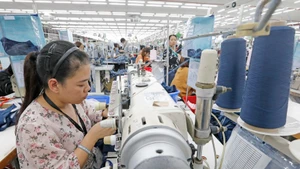The nearly-400-kilometre railway, expected to have a total investment of around 11.6 billion USD, will pass through nine provinces and cities, namely Lao Cai, Yen Bai, Phu Tho, Vinh Phuc, Hanoi, Bac Ninh, Hung Yen, Hai Duong and Hai Phong. Its construction is expected to start at the end of 2025 and be completed by the end of 2030.
Inspecting the site that connects with the Chinese railway and the proposed site to build the Lao Cai station, PM Chinh urged the Ministry of Transport to closely coordinate with relevant ministries, sectors, and localities to complete the project's dossiers, especially regarding investment policies and mechanisms, to submit to the Government and competent authorities for consideration.
He emphasised that this is an important project that needs to be implemented soon, so the procedures should be streamlined.
The selection of design consultants and construction contractors should also be studied thoroughly and conducted to ensure the project is implemented as quickly as possible, PM Chinh stressed, adding that the railway line should be studied with the most direct and shortest route possible, without following the old route.
He also called for adjustments to the number and locations of cargo and passenger stations to ensure effective operations.
In addition, the design of the train speed and track gauge must ensure smooth and synchronised connectivity with the railway line of China. In particular, close coordination with the Chinese side is essential to implement the project in a concerted manner, ensuring seamless connectivity between the railways of the two countries, he said.
Highlighting the need for a long-term vision, the Government leader requested that, alongside completing the railway project, relevant ministries, sectors, and localities must work together to build logistics zones, service warehouses, free trade areas, and urban areas to bring into full play the potential of the railway line. This includes researching mechanisms to attract investment in components such as stations, service areas, and logistics, added PM Chinh.
In the afternoon of the same day, the Government leader attended the groundbreaking ceremony for the Golden Square Lao Cai social housing project in Bac Lenh ward, Lao Cai city.
Implemented by a consortium of the Dong A Golden Square and Foodinco Quy Nhon JSCs, the project covers an area of 42,317.7 sq.m, accommodating a population of approximately 5,600 people. It is designed to feature four buildings ranging from 18 to 23 stories, with a total of 2,189 apartments. The project's total investment is 2.08 trillion VND (81.91 million USD), with completion expected in 2029. The project will include modern landscaping, services, and amenities such as a kindergarten, entertainment centre, outdoor sports clubs, children's playgrounds, green gardens, and parking areas.
In his remarks at the ceremony, PM Chinh stressed that Golden Square Lao Cai contributes to the implementation of the government’s plan to invest in at least 1 million social housing units. He urged the province and other stakeholders to improve their efforts in such development and to complete the goal of eliminating temporary and dilapidated houses by June 2025.
The leader called for localities to continue planning land use and hand over sites to investors promptly. He underscored the importance of collaboration in the implementation of social housing projects with the principle of harmonising benefits and sharing risks.
Moreover, he said, it is necessary to change the perception of the quality and living environment of social housing facilities, ensuring that these homes are of high quality, green, clean, beautiful, and equipped with essential infrastructure, including transport, electricity, water, telecommunications, healthcare, education, and other social services.
In particular, PM Chinh requested relevant authorities to continue improving policies to support buyers, renters, and lease-to-own tenants of social houses, making sure that they are long-term (5-10 years), rather than just two years at present.
















